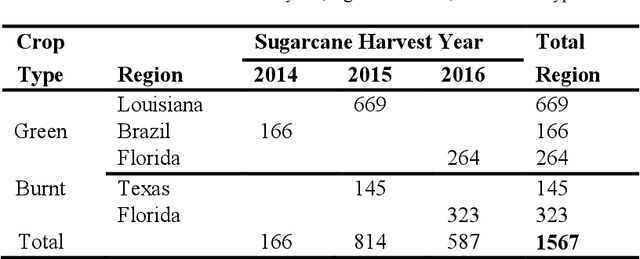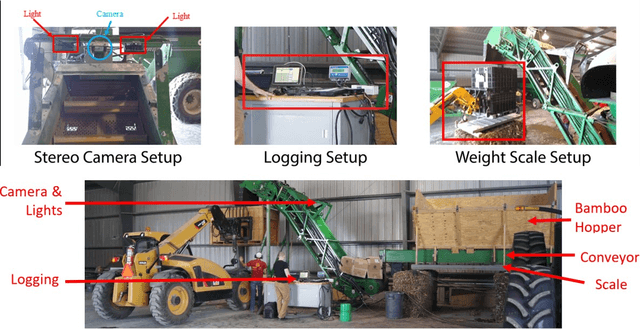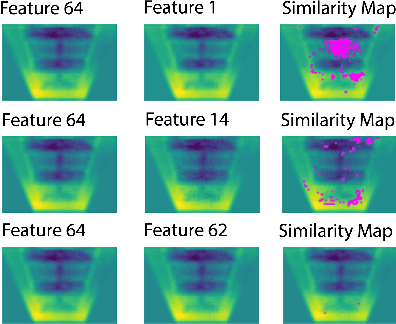Matthew J. Darr
Generalizable semi-supervised learning method to estimate mass from sparsely annotated images
Mar 05, 2020



Abstract:Mass flow estimation is of great importance to several industries, and it can be quite challenging to obtain accurate estimates due to limitation in expense or general infeasibility. In the context of agricultural applications, yield monitoring is a key component to precision agriculture and mass flow is the critical factor to measure. Measuring mass flow allows for field productivity analysis, cost minimization, and adjustments to machine efficiency. Methods such as volume or force-impact have been used to measure mass flow; however, these methods are limited in application and accuracy. In this work, we use deep learning to develop and test a vision system that can accurately estimate the mass of sugarcane while running in real-time on a sugarcane harvester during operation. The deep learning algorithm that is used to estimate mass flow is trained using very sparsely annotated images (semi-supervised) using only final load weights (aggregated weights over a certain period of time). The deep neural network (DNN) succeeds in capturing the mass of sugarcane accurately and surpasses older volumetric-based methods, despite highly varying lighting and material colors in the images. The deep neural network is initially trained to predict mass on laboratory data (bamboo) and then transfer learning is utilized to apply the same methods to estimate mass of sugarcane. Using a vision system with a relatively lightweight deep neural network we are able to estimate mass of bamboo with an average error of 4.5% and 5.9% for a select season of sugarcane.
Mass Estimation from Images using Deep Neural Network and Sparse Ground Truth
Sep 10, 2019



Abstract:Supervised learning is the workhorse for regression and classification tasks, but the standard approach presumes ground truth for every measurement. In real world applications, limitations due to expense or general in-feasibility due to the specific application are common. In the context of agriculture applications, yield monitoring is one such example where simple-physics based measurements such as volume or force-impact have been used to quantify mass flow, which incur error due to sensor calibration. By utilizing semi-supervised deep learning with gradient aggregation and a sequence of images, in this work we can accurately estimate a physical quantity (mass) with complex data structures and sparse ground truth. Using a vision system capturing images of a sugarcane elevator and running bamboo under controlled testing as a surrogate material to harvesting sugarcane, mass is accurately predicted from images by training a DNN using only final load weights. The DNN succeeds in capturing the complex density physics of random stacking of slender rods internally as part of the mass prediction model, and surpasses older volumetric-based methods for mass prediction. Furthermore, by incorporating knowledge about the system physics through the DNN architecture and penalty terms, improvements in prediction accuracy and stability, as well as faster learning are obtained. It is shown that the classic nonlinear regression optimization can be reformulated with an aggregation term with some independence assumptions to achieve this feat. Since the number of images for any given run are too large to fit on typical GPU vRAM, an implementation is shown that compensates for the limited memory but still achieve fast training times. The same approach presented herein could be applied to other applications like yield monitoring on grain combines or other harvesters using vision or other instrumentation.
 Add to Chrome
Add to Chrome Add to Firefox
Add to Firefox Add to Edge
Add to Edge